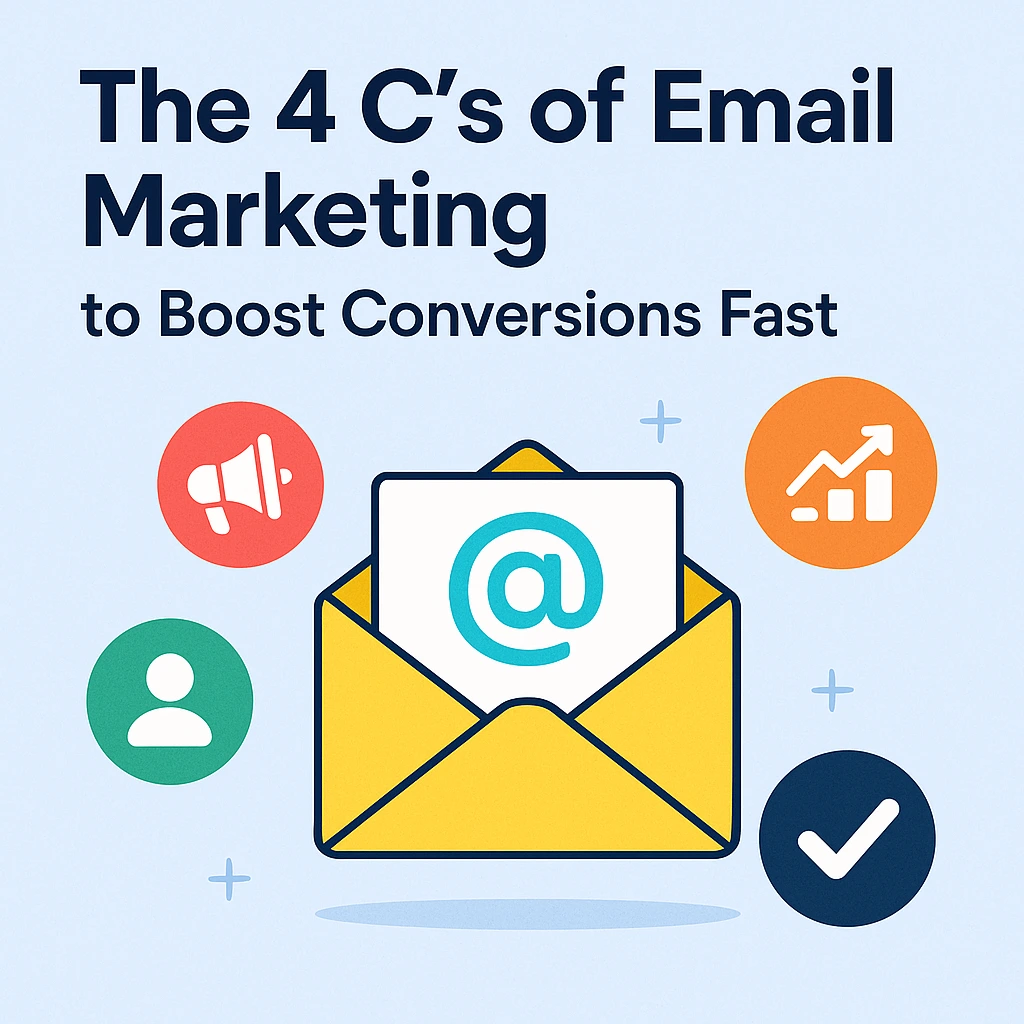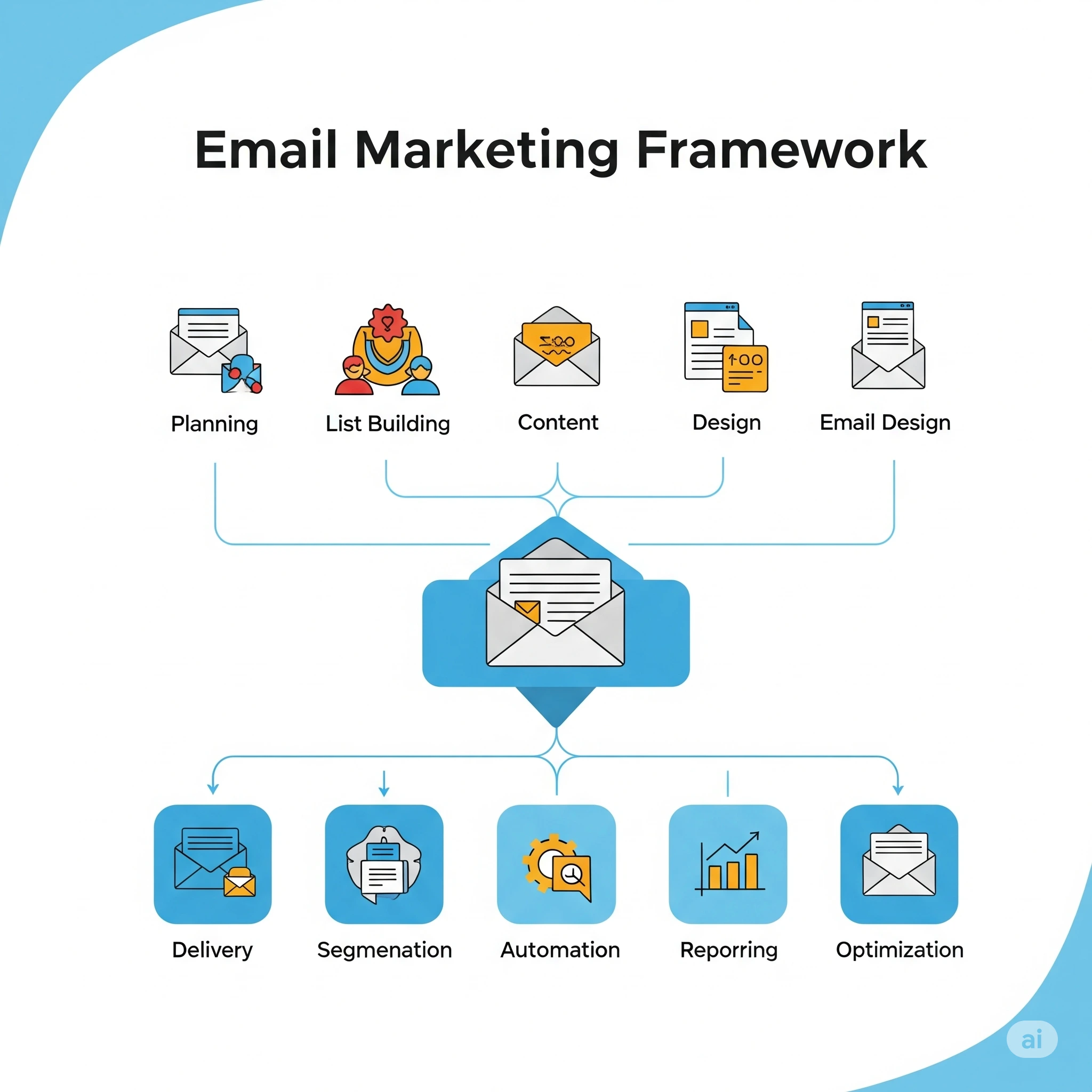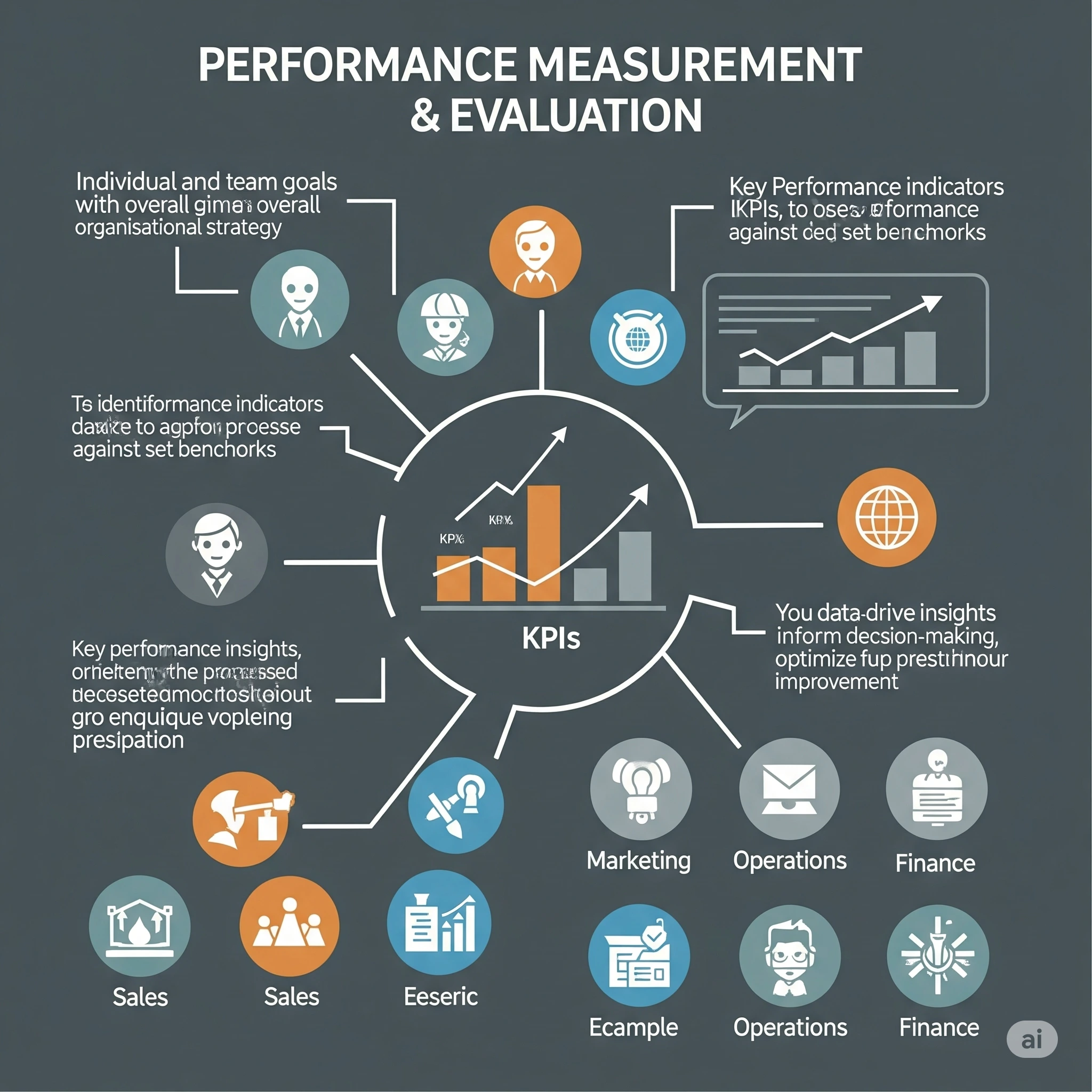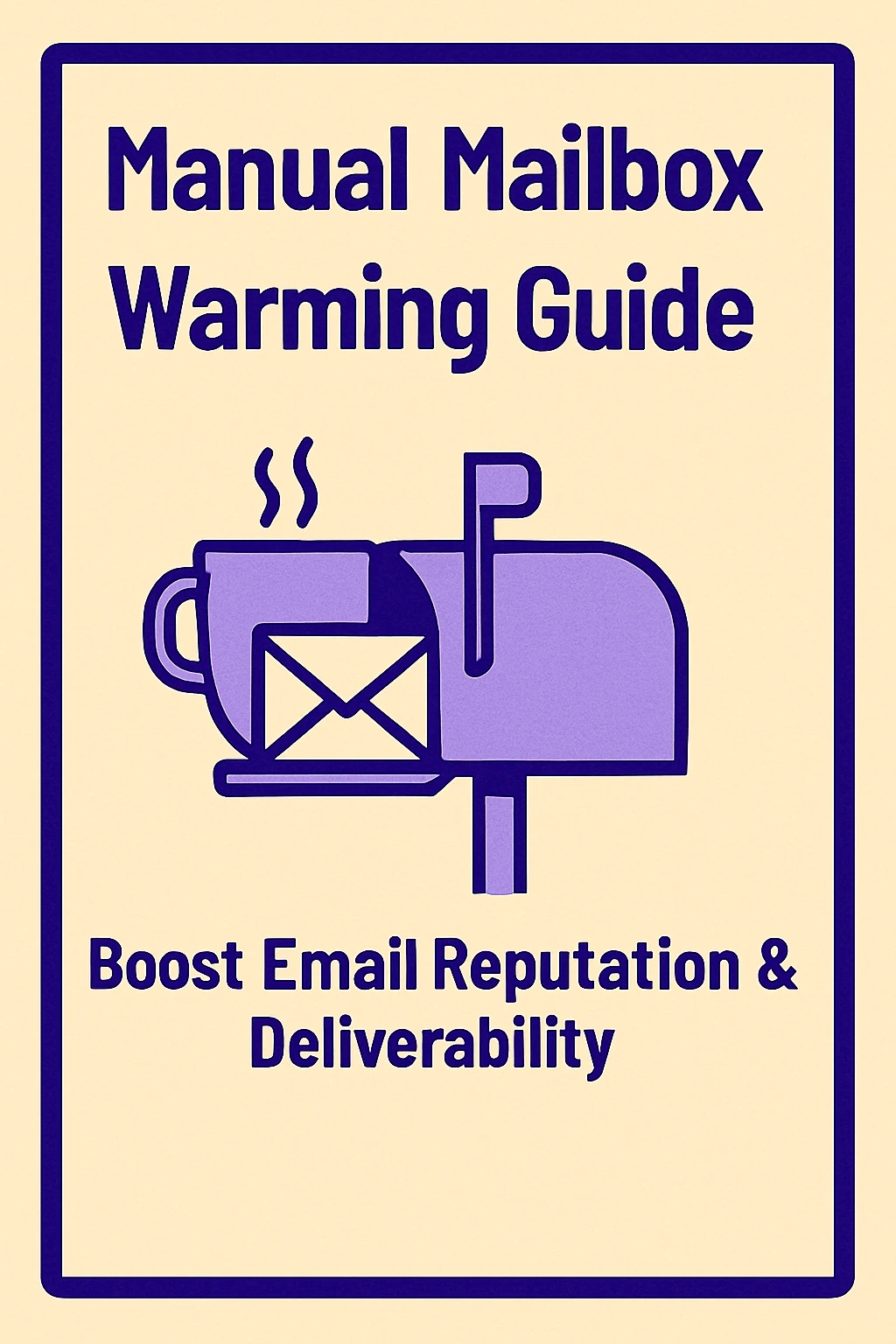The 4 C's of Email Marketing to Boost Conversions Fast
In a world where inboxes are overflowing and attention spans are shrinking, sending effective emails isn’t about more volume, it’s about more intention. The 4 C’s of Email Marketing—Craft, Connect, Convert, and Continue—give you a clear, practical framework to cut through the noise and deliver campaigns that actually perform. This blog breaks down each “C” with real-world strategies, examples, and insights you can apply right away—whether you’re nurturing leads, driving sales, or building lasting customer relationships. If you’re tired of guessing what works and ready to build smarter email flows that convert, this is the guide you’ve been waiting for.

In today’s digital world, your audience’s attention is under constant attack. Every day, people open their inboxes to find dozens, sometimes hundreds of messages all competing for a split second of their time. Most of those emails get ignored, skimmed, or deleted without a second thought. That’s why simply sending more emails doesn’t work anymore. Volume isn’t the answer, relevance is. To stand out, your emails need to feel intentional, timely, and genuinely useful to the reader. When your messaging is scattered or your timing is off, you’re not just missing opportunities you’re training your audience to tune you out. And once they stop paying attention, it’s a long road to win them back.
That’s where the 4 C’s of Email Marketing come in Craft, Connect, Convert, and Continue. This isn’t some gimmicky formula. It’s a practical framework that brings clarity to your strategy and helps you build campaigns that work. Think of it as a guide that keeps you focused on the stuff that moves the needle: writing content that resonates, reaching the right people at the right time, turning interest into action, and keeping relationships alive after the first click. It’s not about chasing hacks or quick wins, it's about building an email program that delivers long-term value. The 4 C’s bring the structure back to the chaos and help you shift from sending noise to creating real, measurable impact.
Why Do You Even Need a Framework for Email?
Look, email marketing isn’t hard because of the tools. It’s hard because most teams skip the planning. We jump into writing copy or scheduling blasts before we’ve answered the most important question: Why are we sending this in the first place?
The 4 C’s keep your process grounded. They help you build emails that aren’t just “pretty” but purposeful. This structure lets you zoom in on the details—subject lines, timing, follow-up flows—without losing sight of the bigger picture.

C #1: Craft – Make It Worth Reading
Craft is the foundation of every great email campaign. It’s not just about stringing together words—it’s about knowing your audience and delivering a message that hits home. From the subject line to the closing CTA, your content needs to be sharp, clear, and purposeful. Think emotionally resonant, visually clean, and easy to scan, especially on mobile. Great crafting also includes smart use of visuals, well-placed buttons, and a message that’s focused—not cluttered. If your email doesn’t earn attention right away, the rest won’t matter. Craft is where you either win or lose your reader’s interest within seconds.
Subject Lines Need to Be Earned, Not Written
You’re not trying to win a copywriting contest. You’re trying to get open. That means ditching the fluff and focusing on what matters to the reader. Curiosity, relevance, timing. These three things decide whether your email gets read or deleted.
For example:
- “You're almost out of stock…” (eCom)
- “This changed how our team sells.” (B2B SaaS)
- “Here’s what you missed this week.” (Newsletters)
Personalization Isn’t About Names
You’ve seen it: “Hi John, just checking in.” Yawn. Real personalization means context. It means recognizing that someone downloaded your whitepaper two days ago and now needs a follow-up that matters. Speak to behavior, not just identity.
Design Should Never Get in the Way
The best-looking email is the one that’s clear. No overstuffed templates, no ten CTAs, no walls of text. Just one idea. One offer. And an obvious path. Mobile-first, fast-loading, easy to scan. Period.
C #2: Connect – Get to the Right Person at the Right Time
Even the best email won’t work if it never reaches the right person. That’s where Connect comes in. It’s about smart segmentation, timely delivery, and strong sender reputation. You need to make sure your message lands in the inbox—not in spam—and that it arrives when your audience is most likely to engage. That means maintaining a clean list, authenticating your domain, and understanding your subscribers’ behavior. With good Connect practices, your emails don’t just get delivered—they feel relevant, personal, and well-timed. This is where platforms like MailKarma.ai give you the edge, helping you monitor placement and sender score in real time.
List Segmentation Is Not Optional Anymore
Think beyond demographics. Group your audience by behavior, lifecycle stage, or intent. A person who abandoned a cart needs a different email than someone who just became a customer. One-size-fits-all is dead.
Deliverability Isn’t Sexy, But It’s Critical
No one wants to talk about SPF, DKIM, and DMARC—but they’re the backbone of your inbox presence. If your emails aren’t getting delivered, everything else is a waste of time. Use a tool like MailKarma.ai to monitor inbox placement and keep your sender reputation clean.
Don’t Just Schedule—Strategize Your Send Times
Stop guessing. Open rates change depending on your audience’s behavior. If you’re in B2B, Tuesday at 10 a.m. might work. For eCommerce, weekends may perform better. Use your data. Run tests. And for the love of ROI, stop batch-sending at midnight.
C #3: Convert – Make the Next Step Obvious
Once your email is opened, Convert is where the magic happens. This is the stage that turns interest into action—whether that’s clicking a button, filling out a form, or completing a purchase. The key here is simplicity. Your message should have one clear goal and your call-to-action should guide the reader toward it without confusion. You also need continuity between your email and the landing page—same tone, same offer, same message. If people click but don’t complete the action, something’s broken in the experience. Convert is about reducing friction, creating urgency, and making the next step irresistible.
Every Call-to-action Needs a Purpose
No one clicks “Learn More” unless it’s obvious what they’re going to learn. Replace vague buttons with clear values.
Try:
- “Download Your Free Report”
- “Reserve My Spot”
- “Get 15% Off Before It’s Gone”
Make your CTA feel like a benefit, not a command.
Match Your Landing Page Like It’s the Same Room
Everclickedk on a promo email and landed on a generic homepage? That’s how you kill momentum. Your email and landing page should feel like two parts of the same experience. Keep the message, offer, and tone consistent.
Use Proof Over Persuasion
People trust other people more than they trust marketing. Include a short testimonial, a user count (“Join 5,000+ marketers”), or a quote from a real customer. It’s subtle but powerful.
C #4: Continue – Keep the Conversation Going
Most email marketers stop after the conversion—but the real opportunity lies in what happens next. Continue is about nurturing your subscribers after that first action. Think welcome series, post-purchase flows, re-engagement campaigns, and personalized content that keeps your brand top of mind. This is how you build relationships, not just transactions. You want your emails to add value long after the initial click—so your subscribers become repeat buyers, loyal customers, or brand advocates. Metrics like customer lifetime value, retention, and repeat purchases start here. Continue ensures your email program isn’t a one-time effort—it’s an ongoing journey.
The Sale Isn’t the End
When someone becomes a customer, it’s your opportunity to double down. Send onboarding emails, usage tips, or exclusive access. If your product or service has a learning curve, guide them through it.
Re-Engage Quiet Subscribers With Value, Not Guilt
Haven’t opened in a while? Don’t beg. Instead, offer something worth their attention. A behind-the-scenes update. A surprise offer. Or just a well-written message that says, “Here’s why you might want to check in again.”
Measure Lifetime Value, Not Just Clicks
Track how often people convert, how much they spend, and what keeps them coming back. Email can be your most consistent revenue driver if you use it to deepen—not just start—the relationship.
How Do You Know If Each “C” Is Working?

Let’s be real, email metrics can get overwhelming fast. You send a campaign, check the dashboard, and suddenly you’re staring at a wall of numbers. But not all data points tell the full story. When you break things down using the 4 C’s—Craft, Connect, Convert, and Continue you can make sense of what’s working and where things need a fix.
Craft: Is Your Message Catching Eyes or Being Ignored?
This part is all about earning that first moment of attention. Look at your open rates first. Are people even opening your emails? If they are, what happens next do they stick around or bounce right out? Scroll depth and read time will show you whether your content is connecting or falling flat. If people aren’t engaging past the headline, you may need to rethink how you’re framing your message.
Connect: Are You Landing in the Inbox or Getting Lost in Spam?
You could write the world’s best email, but it won’t matter if it never reaches your audience. This stage is about deliverability. If your bounce rate is climbing or you’re seeing weird drops in engagement, something might be off. Maybe your list is outdated. Maybe your sender's reputation needs attention. A tool like MailKarma.ai can help you track how often you’re hitting inboxes instead of junk folders and flag problems before they grow.
Convert: Are People Clicking and Taking Action?
This is where you find out if your email is doing its job. Are people clicking your CTA? Are they following through and converting on your offer? If your open and click rates are solid but conversions are low, your landing page or value proposition might not be lining up with the email. It's not just about traffic, it’s about momentum.
Continue: Are You Building Long-Term Loyalty—or Just One-Off Wins?
Getting a sale or signup is great, but that’s just the beginning. This “C” is about what happens after the click. Are customers coming back? Do they open future emails? Are they sticking around long enough to become loyal fans? Metrics like repeat purchase rate, engagement over time, and lifetime value tell you whether you’re building real relationships or just chasing short-term wins.
Wrap-Up: Why the 4 C’s Work
Email marketing today demands more than just showing up in someone’s inbox—it demands purpose. Your audience is smarter, busier, and more selective. They expect messages that feel timely, relevant, and worth their attention. That’s exactly what the 4 C’s—Craft, Connect, Convert, and Continue—are designed to deliver. This framework strips away the guesswork and gives you a strategy that’s focused, repeatable, and proven to work. No fluff. No shortcuts. Just smart, thoughtful email marketing that turns casual readers into active customers—and loyal customers into brand advocates.
No fluff. No gimmicks. Just a strategy that moves people from inbox to action, and from customer to loyal advocate.
Ready to Make Email Work Harder for You?
Start by making sure your emails actually land where they should. With MailKarma.ai, you’ll get real-time insights into inbox placement, engagement performance, and your sender reputation. It’s everything you need to stop guessing—and start sending emails that get seen and drive results.
FAQs
1. What exactly are the 4 C’s in email marketing?
They stand for Craft, Connect, Convert, and Continue. It’s a simple framework to create engaging emails, reach the right people, drive action, and build long-term relationships.
2. How is this different from traditional email marketing?
Traditional tactics focus on opens and clicks. The 4 C’s help you think bigger—about the full customer journey and how to improve each stage, not just the first step.
3. Can I use the 4 C’s with the platform I already have?
Yes, it works with any email tool—Mailchimp, Klaviyo, HubSpot, and more. It’s a strategy shift, not a tech change.
4. Is this framework meant for B2B, B2C, or both?
Both. It adapts to your audience—B2B for nurturing, B2C for urgency and offers—but the structure works across the board.
5. How do I know if my emails are truly connecting with my audience?
Check open rates, clicks, bounce rate, and deliverability. If things look off, tools like MailKarma.ai can help you spot and fix deliverability issues quickly.
Recent Blogs
FAQs: Everything You’re Wondering About Cold Email Deliverability & MailKarma’s Infrastructure
MailKarma is a dedicated email infrastructure solution built exclusively for cold email outreach. Unlike shared inbox tools or general ESPs, MailKarma gives you complete control over your sending setup—private US IPs, clean domains, and expert-backed deliverability practices. Built by cold email pros, MailKarma is optimized to scale outreach without landing in spam.
Because MailKarma sets up private infrastructure—including custom domains and mailboxes—it doesn’t offer a traditional free trial. However, you can explore the platform, view your dashboard, and test features before provisioning infrastructure. Our private dedicated email servers cost $150 per server plus $0.001 per email sent, making it extremely cost-effective for high-volume cold email campaigns. For Gmail Workspace solutions, pricing starts at $3.50 per email with a 10-email minimum, dropping to $2.50 per email for volumes over 100 emails. This transparent pricing model ensures you only pay for what you use while maintaining enterprise-grade email deliverability.
Yes. MailKarma automatically sets up SPF, DKIM, and DMARC records using best-in-class standards. No technical hassle—our system handles everything behind the scenes, and our support team is always ready to assist if needed.
Every MailKarma subscription includes:
- Automated DNS setup (SPF, DKIM, DMARC)
- Private mailbox hosting
- Ongoing deliverability optimization
- Server monitoring and uptime guarantees
It depends on your monthly sending volume and the number of contacts per sequence. To simplify this, MailKarma includes a volume-based calculator inside the app to help you choose the optimal setup for scale, safety, and inbox placement.
Gmail and Outlook aren't built for cold outreach—they throttle volume, rotate IPs, and limit deliverability. MailKarma gives you:
- Dedicated infrastructure
- Warmed IPs and aged domains
- No shared resources
- Built-in best practices for cold outreach
It's the infrastructure your outreach actually needs.

.png)



